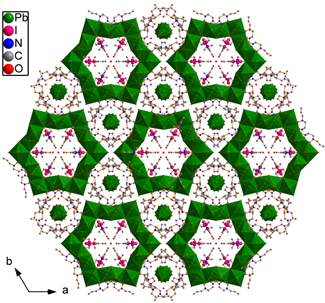| Inorganic Semiconductor Nanotube Arrays Build by [PbII18I54(I2)9] Wheel Clusters |
| From: PublishDate:2017-06-16 Hits: |
Carbon nanotubes have shown great success on the research of fuel cell, battery, supercapacitor, lightweight electrical conductors, flexible electronics and heaters. Inspired by carbon nanotubes, scientists also create a lot of other crystalline inorganic nanotube arrays. However, they are limited in oxides and chalcogenides. It is still a big challenge to prepare well-defined inorganic nanotube array with other elements. Teams from state key laboratory of structural chemistry have gained insight into the metal halide nanotube. Their research has been published on January 11th 2016 in Angew. Chem. Int. Ed., and was chosen as Frontispiece.
They synthesized the metal halide crystalline inorganic nanotube for the first time. The [PbII18I54(I2)9] wheels are integrated with each other in face-to-face manner by the I-I covalent bonds to form [PbII18I54(I2)9]n nanotube with a crystallographic 63 screw axis running through the center of the nanotube. Up to now, Wheel cluster shows much diversity and tunability on its structure: metal can be V, Mo, Cr, W, Nb et al, that are limited in polyoxometalates and chalcogenide. The electrical properties of this nanotube based on single-crystal were also studied and show significantly anisotropic semiconductive behavior. Under room temperature, the conductivity along the nanotube is about 1 order of magnitude higher than that perpendicular to the nanotube, which further increases to ~2 orders of magenitude at 180 oC. The conductivity also shows anisotropic temperature effect: from room temperature to 180 oC, the conductivity along the nanotube increases with the value of ~3 orders of magnitude, while the conductivity perpendicular to the nanotube increases only ~2 orders of magnitude.
From the help of Beijing Synchrotron Radiation Facility (BSRF), they gained the whole structure of the nanotube. And found that the wheel cluster [PbII18I54(I2)9] was constructed by six Pb3I13 trimers linking with each other end-to-end in D3 symmetry, with the outer diameter of 2.53 nm and the inner diameter of about 1.32 nm. This is the biggest metal halide wheel cluster. The wheel cluster connected by I-I covalent bonds to form [PbII18I54(I2)9]n nanotube. Isolated (PbII2I9)5? cluster, I– ions, propylated (Pr2DABCO)2+ dications, and lattice water molecules are filling in and out the nanotubes. Because of huge electron number disparity between inorganic iodoplumbate and organic Pr2DABCO2+, it is difficult to determine the organic part by normal lab X-ray instrument. Synchrotron X-ray diffraction helped to gain the whole single crystal structure successfully. Publication: Guan-E Wang, Gang Xu,* Bin-Wen Liu, Ming-Sheng Wang, Ming-Shui Yao, Guo-Cong Guo*, Semiconductive Nanotube Array Constructed By Giant [PbII18I54(I2)9] Wheel Clusters, Angew. Chem. Int. Ed., 2016, 55, 514-518. |
|
|
| Chinese
- Metal-free efficient photocatalyst for stable visible water splitting——Top ten major scientific progresses in China in 2015
- The nano-resolution imaging platform was awarded the first rate prize of Beijing Science and Technology in 2014
- Beamline 1W1 of BSRF started to runoperate in the couplingparasitic mode of BEPCII
- Synthesis of High Performance Polymer Materials for Field Effect-Transistors
- Surfactant molecular aggregates in green solvents
- GIXRD has played an important role in the characterization of organic thin-film transistors
Copyright © 2011 - 2012 Beijing Synchrotron Radiation Facility



